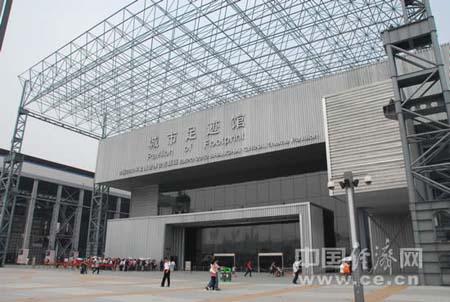|
|


ADVERTISEMENT
Buy Your own advertising
spaces!
.
Download Adobe Acrobat Reader to open [PDF] files.
Recent Visitors
Cultural relics shown at Shanghai Expo
2010. 27 May
 The Urban Footprint Pavilion is focusing on the past, present, and future of the people and the cities they live in. (Photo: CNTV.cn)
The Urban Footprint Pavilion is focusing on the past, present, and future of the people and the cities they live in. (Photo: CNTV.cn)
by Xinhua
(news.xinhuanet.com)
Apart from various pavilions representing different nationalities at the 2010 Shanghai World Expo, there are also pavilions focusing on the past, present, and future of the people and the cities they live in.
The Urban Footprint Pavilion is one of them. Among the highlights visitors see at the venue are ten priceless pieces from Dunhuang Grotto of Northwest China's Gansu Province.
Upon entering the pavilion, visitors will find themselves surrounded by fresco replicas from Mogao Grottos depicting the lifestyle of the Tang Dynasty some one-thousand years ago.
On display are also Tang Dynasty Buddhism sutras and Buddha sculptures.
Over the past four years, the Shanghai Museum has taken on the task of planning the exhibition inside the Urban Footprint Pavilion. They have attempted to present a clear timeline of the urban development of humanity.
Chen Xiejun, Curator of Shanghai Museum, said, "This is the first that these ten relics to be shown out of Dunhuang. Visitors to the 2010 Shanghai World Expo are very lucky to see these national treasures."
Among the ten national treasures, a wooden sculpture of the six-armed Guanyin captures the most attention. The 65 centimeter statue is partly damaged due to years of weathering, and is among the few Tang Dynasty wooden sculptures of Guanyin that exists in the world today.
Chen Xiejun, Curator of Shanghai Museum, said, "This wooden piece is representative of all the art pieces in Dunhuang. We know that women in big physical sizes were regarded beauties back in the Tang Dynasty. This statue fully displays the characteristics of what the Tang people thought were beautiful."
There's also a clay figurine of a Bodhisattva, attracting the public attention for its well-preserved colorful apparel. As curator Chen explains, the waistline of the statue is barrel shaped to show a full and round body contour, which was embraced by the open-minded aristocratic women some one-thousand years ago.
(CNTV.cn)
Source: news.xinhuanet.com

